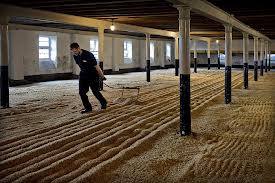Unraveling the Secrets of Malted Barley: An Essential Ingredient in Your Favorite Beers

As lovers of craft beer, you likely already have an understanding of the basic ingredients that go into your favorite brews: water, hops, yeast, and of course, malted barley. But have you ever wondered about the process behind malted barley production? Or how local craft maltsters, like Asheville’s own Riverbend Malthouse, are bringing unique flavors to the beers you love? Let’s delve into the world of malted barley and explore the malt houses that are central to American brewing.
What is Malted Barley?
Malted barley is essentially barley that has been germinated and dried in a controlled environment. The purpose of malting is to convert the starches in the barley into fermentable sugars. These sugars will then be eaten by yeast during the brewing process to produce alcohol and CO2, giving us the delicious beer we all enjoy.
How Is Malted Barley Produced?
The production of malted barley involves a three-step process:
Steeping: The raw barley is soaked in water for a couple of days to initiate germination. This is where the moisture content of the barley increases, activating the enzymes within the grain.
Germination: The moist barley is allowed to germinate in a controlled environment. During this stage, the enzymes begin converting the grain’s starches into sugars.
Kilning: The germinated barley is dried in a kiln to stop the germination process. This step also imparts the color and flavor characteristic of the malt, depending on the temperature and duration of kilning.
Larger Malthouses in the United States
Several malt houses across the United States supply malted barley to breweries. Some of the more notable ones include:
The Rise of Craft Maltsters: Riverbend Malthouse in Asheville
In the craft beer revolution, many brewers have turned to craft maltsters who produce malt on a smaller scale but with more variety and local character. One such craft maltster is right here in Asheville: Riverbend Malthouse.
Riverbend Malthouse is unique because it sources all of its barley from local farmers within a 500-mile radius of Asheville. This commitment to local agriculture not only supports the local economy but also creates a unique “terroir” for their malts, reflecting the soil, climate, and growing conditions of the region.
The malting process at Riverbend follows the same basic steps as larger maltsters, but with a small-batch, hands-on approach that allows for a higher degree of control and innovation. Different varieties of barley, along with varying steeping times, germination conditions, and kilning temperatures, result in a wide array of malt flavors and colors, from the lightest Pilsner malts to the darkest Chocolate malts.
You can check out more about Riverbend Malthouse here.
In the end, malted barley may be one of many ingredients in beer, but its importance cannot be overstated. It provides the sugars necessary for fermentation, flavors that shape the beer’s character, and the colors that catch your eye. Next time you join us on a BREW-ed Brewery Tour, you’ll appreciate the role of malted barley, and malt houses like Riverbend Malthouse, even more.

